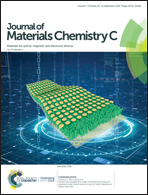Fabrication and nonlinear optical characterization of fluorinated zinc phthalocyanine covalently modified black phosphorus/PMMA films using the nanosecond Z-scan technique†
Abstract
As one of the excellent and attractive building blocks, phthalocyanines (Pcs) exhibit outstanding electronic, optoelectronic and optical properties. It would thus be very interesting and challenging to covalently functionalize the well-known star material “2D black phosphorus (BP)” with Pcs. By using a newly synthesized zinc phthalocyanine-based diazonium salt, F12PcZn–N2+BF4−, as the synthetic precursor, a novel F12PcZn–BP nanohybrid material with a direct covalent linkage between the PcZn complex and the BP nanosheets was synthesized and embedded into a poly(methyl methacrylate) (PMMA) matrix producing a PMMA-based film with good optical quality. Compared to the BP/PMMA and F12NH2PcZn/PMMA films, the F12PcZn–BP/PMMA film shows more superior nonlinear optical (including optical limiting) properties. After annealing in N2 at 200 °C for 30 minutes, the achieved nonlinear absorption coefficient (βeff) and limiting threshold are changed from 177.10 cm GW−1 and 0.72 GW cm−2 for the non-annealed F12PcZn–BP/PMMA film to 263.47 cm GW−1 and 0.61 GW cm−2, respectively.



 Please wait while we load your content...
Please wait while we load your content...